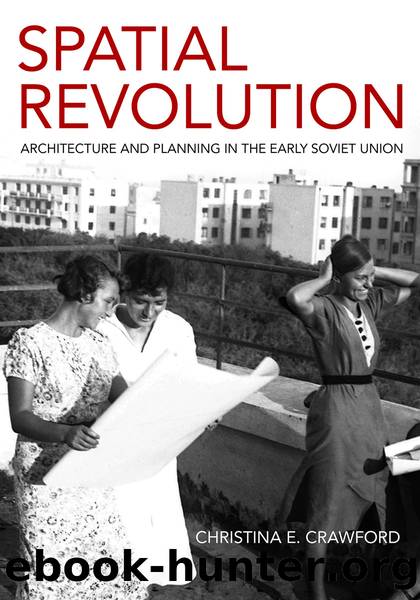SPATIAL REVOLUTION by Christina E. Crawford

Author:Christina E. Crawford
Language: eng
Format: epub
Publisher: Cornell University Press
Published: 2021-09-11T00:00:00+00:00
Figure 6.3. Laying the first housing foundation, Pionerskaia Street, Magnitogorsk, Russia, summer 1930. Magnitogorskii kraevedcheskii muzei.
Figure 6.4. Aerial view of factory construction with rows of wooden barracks in the distance, Magnitogorsk, Russia, c. 1930. Magnitogorskii kraevedcheskii muzei.
Figure 6.5. Family barracks, Magnitogorsk, Russia, c. 1931. Magnitogorskii kraevedcheskii muzei.
Internal Competition
After site reconnaissance, a month-long internal design competition ensued. Chernyshev working for Giprogor, and May for Tsekombank, were ordered by the Magnitostroi administration to complete planning schemes for the city by November 25, 1930, less than a month into the future.52 Mayâs team, used to working quickly, immediately began sketching alternatives in Magnitogorsk, continued on the train journey, and finished in Moscow. They purportedly converted one of their train compartments into a drafting room and âusing the charcoal supplied as fuel for the samovar as pencils and drafting boards made of plywood pieces as a drawing baseâ produced a draft of a general plan.53 In another compartment colleagues typed up the explanatory texts for the project. The Tsekombank regional plan by the May team, dated November 1930, shows rectangular residential blocks originating at the southern end of the production zone and sweeping to the southeast (figure 6.6). The topographical model of this scheme explains the bowed shape of the housing region: it sits between the mine and industrial lake to the north, and a row of hills to the south, on the flattest land available close to the industrial zone (plate 14). The detailed site plan reveals that the Tsekombank scheme had much in common with the majority of the All-Union competition entries for Magnitogorsk, especially the âconcentrated city planningâ examples (figure 6.7). Repetitive residential communes fill in a wide band that wends its way in a southeasterly direction. Mayâs standard residential building for Magnitogorsk is a zeilenbau of the Frankfurt type, a simple double exposure bar oriented along the north-south axis for maximal east-west insolation. In the birdâs eye perspective, a drawing that uses perspectival drama to mask extreme regularity, blocks (kvartaly) for 8,000â10,000 residents extend into the distance in repeated rectangles; all buildings stand free, surrounded by green space (figure 6.8).54
Chernyshev was in the unenviable position of having to explain to his client that the project he had been working on for over a year was about to be snatched away. In a letter to the director of Giprogor, Chernyshev complained about chronic decision-making dysfunction on Magnitogorskâs fundamental planning questions. The very location of the city was still up for grabs. âWe consider the choice of cityâs site to be the most critical task that stands before the State Commission,â Chernyshev stressed.55 Almost two weeks after receipt of the letter, someone at Giprogor scribbled an elliptical note at the topââwhat should we do about this question?ââthat confirms that Chernyshev was plagued by indecision on all sides. Nevertheless, he and his Giprogor team pushed through and finished their version of the Magnitogorsk general plan. In every planning scheme he devised for Magnitogorsk, Chernyshev utilized a fan-shaped organizational strategy that resembles a quarter
Download
This site does not store any files on its server. We only index and link to content provided by other sites. Please contact the content providers to delete copyright contents if any and email us, we'll remove relevant links or contents immediately.
Kathy Andrews Collection by Kathy Andrews(11737)
The remains of the day by Kazuo Ishiguro(8832)
Paper Towns by Green John(5092)
Spare by Prince Harry The Duke of Sussex(5078)
Industrial Automation from Scratch: A hands-on guide to using sensors, actuators, PLCs, HMIs, and SCADA to automate industrial processes by Olushola Akande(4999)
The Body: A Guide for Occupants by Bill Bryson(4978)
Machine Learning at Scale with H2O by Gregory Keys | David Whiting(4199)
Be in a Treehouse by Pete Nelson(3955)
Never by Ken Follett(3800)
Harry Potter and the Goblet Of Fire by J.K. Rowling(3776)
Goodbye Paradise(3729)
Into Thin Air by Jon Krakauer(3314)
The Remains of the Day by Kazuo Ishiguro(3296)
The Cellar by Natasha Preston(3264)
The Genius of Japanese Carpentry by Azby Brown(3228)
Fairy Tale by Stephen King(3227)
120 Days of Sodom by Marquis de Sade(3185)
Drawing Shortcuts: Developing Quick Drawing Skills Using Today's Technology by Leggitt Jim(3001)
The Man Who Died Twice by Richard Osman(2998)
